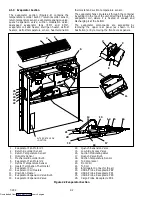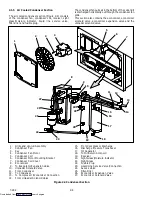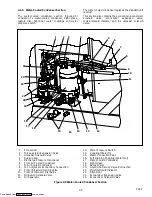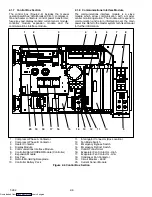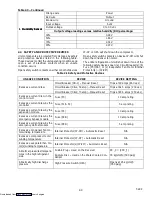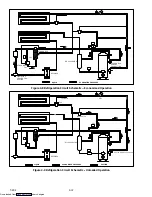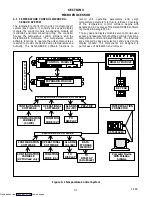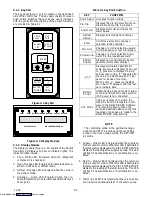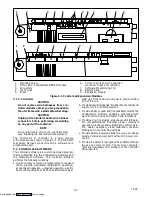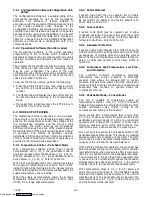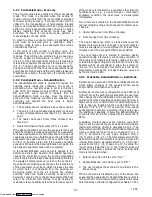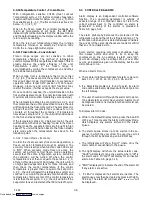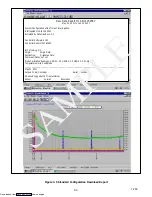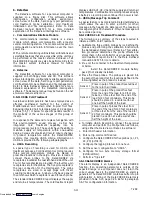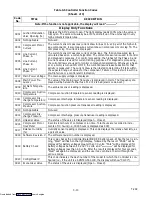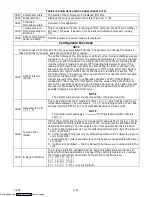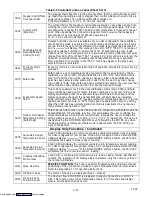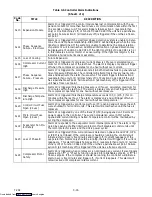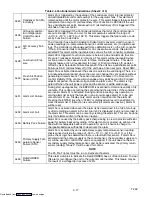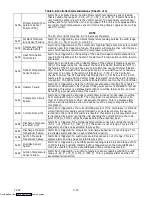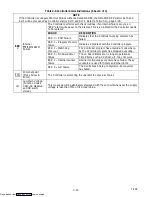
3-4
T-292
3.2.1 Configuration Software (Configuration Vari-
ables)
The Configuration Software is a variable listing of the
components available for use by the Operational
Software. This software is factory installed in
accordance with the equipment fitted and options listed
on the original purchase order. Changes to the
Configuration Software are required only when a new
controller has been installed or a physical change has
been made to the unit such as the addition or removal of
an option. A Configuration Variable list is provided in
Table 3-4. Change to the factory installed Configuration
Software is achieved via a configuration card or by
communications.
3.2.2 Operational Software (Function codes)
The Operational Software is the actual operation
programming of the controller which activates or
deactivates components in accordance with current unit
operating conditions and operator selected modes of
operation.
The programming is divided into function Codes. Some
of the codes are read only while the remaining codes
may be user configured. The value of the user
configurable codes can be assigned in accordance with
user desired mode of operation. A list of the function
codes is provided in Table 3-5.
To access the function codes, perform the following:
a. Press the CODE SELECT key, then press an arrow
key until the left window displays the desired code
number.
b. The right window will display the value of this item for
five seconds before returning to the normal display
mode.
c. If a longer time is desired, press the ENTER key to
extend the time to 30 seconds.
3.3 MODES OF OPERATION
The Operational Software responds to various inputs.
These inputs come from the temperature and pressure
sensors, the temperature set point, the settings of the
the configuration variables and the function code
assignments. The action taken by the Operational
Software will change if any one of the inputs changes.
Overall interaction of the inputs is described as a “mode”
of operation. The modes of operation include,
perishable (chill) mode and frozen mode. Descriptions
of the controller interaction and modes of operation are
provided in the following sub paragraphs.
3.3.1 Temperature Control -- Perishable Mode
With configuration variable CnF26 (Heat Lockout
Temperature) set to --10
_
C the perishable mode of
operation is active with set points
above --10
_
C (+14
_
F).
With the variable set to --5
_
C, the perishable mode is
active
below --5
_
C (+23
_
F
). Refer to Table 3-4.
When in the perishable mode the controller maintains
the supply air temperature at set point, the SUPPLY
indicator light will be illuminated on the display module
and the default reading on the display window will be the
supply temperature sensor reading.
When the supply air temperature enters the in-range
temperature tolerance (as selected at function code
Cd30), the in-range light will energize.
3.3.2 Defrost Interval
Function code Cd27 may be operator set to initiate
defrost at intervals of 3, 6, 9, 12 or 24 hours. It may also
be set to OFF (no defrost). The factory default is 12
hours. Refer to Table 3-5.
3.3.3 Failure Action
Function code Cd29 may be operator set to allow
continued operation in the event that all of the control
sensors are reading out of range. The factory default is
full system shutdown. Refer to Table 3-5.
3.3.4 Generator Protection
Function codes Cd31(Stagger Start, Offset Time) and
Cd32 (Current Limit) may be operator set to control start
up sequence of multiple units and operating current
draw. The factory default allows on demand starting (no
delay) of units and normal current draw. Refer to
Table 3-5.
3.3.5 Compressor High Temperature, Low Pres-
sure Protection.
The controller monitors compressor discharge
temperature and suction pressure. If discharge
pressure rises above the allowed limit or suction
pressure falls below the allowed limit the compressor
will be cycled off on a three minute timer. Condenser and
evaporator fans continue to operate during the
compressor off cycle.
3.3.6 Perishable Mode -- Conventional
The unit is capable of maintaining supply air
temperature to within
¦
0.25
_
C (
¦
0.5
_
F) of set point.
Supply air temperature is controlled by positioning of the
suction modulation valve (SMV), cycling of the
compressor and cycling of the heaters.
When cooling from a temperature that is more than
2.5
_
C (4.5
_
F) above set point, the system will be in the
perishable pull down mode. It will be in economized
operation with a target SMV position of 100% open.
However, pressure and current limit functions may
restrict the valve, if either exceeds the preset value.
Once set point is reached, the unit will transition to the
perishable steady state mode. This results in unloaded
operation with some restriction of the SMV. The SMV
will continue to close and restrict refrigerant flow until the
capacity of the unit and the load are balanced.
If the SMV is at minimum modulation, the controller has
determined that cooling is not required, or the controller
logic determines suction pressure is at the low pressure
limit, the unit will transition to the perishable idle mode.
The compressor is turned off and the evaporator fans
continue to run to circulate air throughout the container.
If temperature rises above set point +0.2
_
C, the unit will
transition back to the perishable steady state mode
If the temperature drops to 0.5
_
C (0.9
_
F) below set
point, the unit will transition to the perishable heating
mode and the heaters will be energized . The unit will
transition back to the perishable idle mode when the
temperature rises to 0.2
_
C (0.4
_
F) below the set point
and the heaters will de-energize
Downloaded from
Summary of Contents for 69NT40-531 Series
Page 2: ...Downloaded from ManualsNet com search engine ...
Page 4: ...Downloaded from ManualsNet com search engine ...
Page 8: ...Downloaded from ManualsNet com search engine ...
Page 16: ...Downloaded from ManualsNet com search engine ...
Page 57: ...Downloaded from ManualsNet com search engine ...
Page 104: ...Downloaded from ManualsNet com search engine ...
Page 106: ...7 2 T 292 Figure 7 2 SCHEMATIC DIAGRAM Downloaded from ManualsNet com search engine ...

